Toxicology Report: Asbestos Exposure and Human Health - SLE312
VerifiedAdded on 2023/01/18
|6
|1368
|69
Report
AI Summary
This report, prepared for the SLE312 Toxicology course, investigates the toxicological impact of asbestos on human health. It begins by outlining the methodology used to study asbestos toxicity, focusing on the selection of stakeholders (specifically children) and the rationale behind this choice. The report then details various diagnostic tests, including chest radiography and pulmonary function tests, used to assess asbestos-related diseases. The preliminary report provides an overview of asbestos, its carcinogenic nature, and the populations most at risk, such as construction workers and their families. It discusses the ADME (Absorption, Distribution, Metabolism, and Excretion) of asbestos fibers in the body, highlighting how inhalation, skin contact, and ingestion can lead to exposure. The report emphasizes the short- and long-term health effects, including chest pain, breathing problems, and the development of malignant mesothelioma. The report concludes by underscoring the significant health risks associated with asbestos exposure, particularly for children, and the importance of early detection and preventive measures. The report references several scientific articles to support its findings.
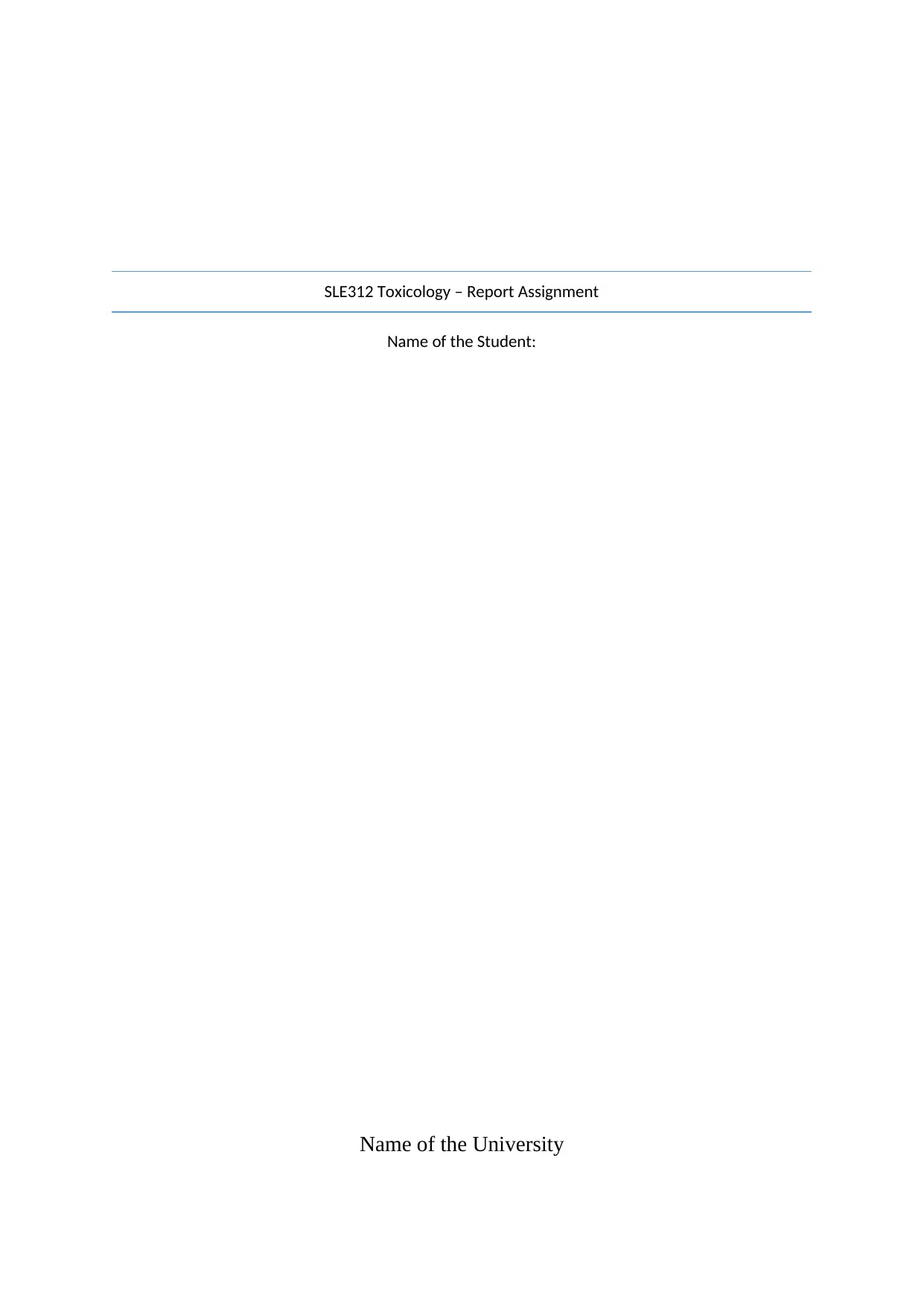
SLE312 Toxicology – Report Assignment
Name of the Student:
Name of the University
Name of the Student:
Name of the University
Paraphrase This Document
Need a fresh take? Get an instant paraphrase of this document with our AI Paraphraser
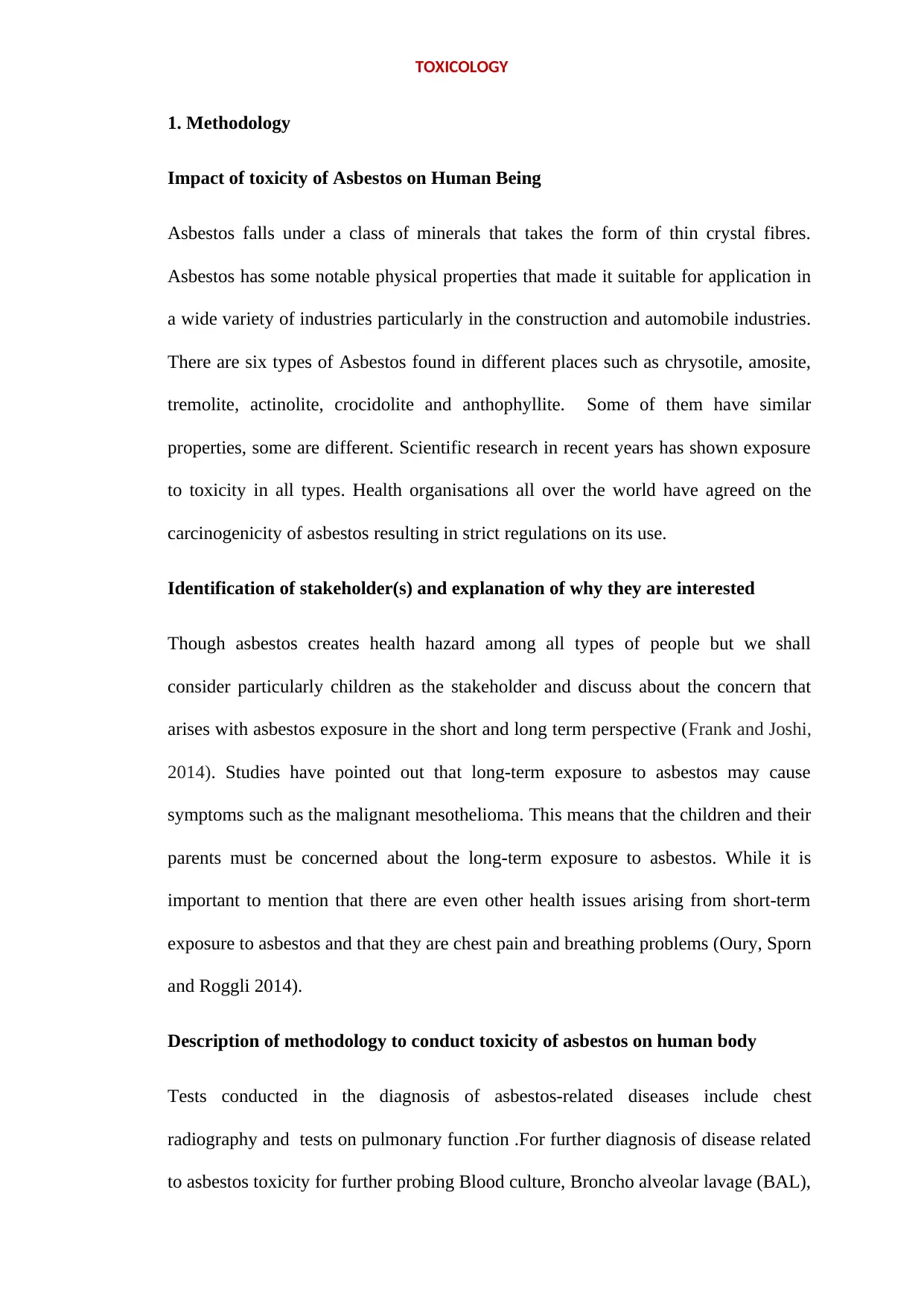
TOXICOLOGY
1. Methodology
Impact of toxicity of Asbestos on Human Being
Asbestos falls under a class of minerals that takes the form of thin crystal fibres.
Asbestos has some notable physical properties that made it suitable for application in
a wide variety of industries particularly in the construction and automobile industries.
There are six types of Asbestos found in different places such as chrysotile, amosite,
tremolite, actinolite, crocidolite and anthophyllite. Some of them have similar
properties, some are different. Scientific research in recent years has shown exposure
to toxicity in all types. Health organisations all over the world have agreed on the
carcinogenicity of asbestos resulting in strict regulations on its use.
Identification of stakeholder(s) and explanation of why they are interested
Though asbestos creates health hazard among all types of people but we shall
consider particularly children as the stakeholder and discuss about the concern that
arises with asbestos exposure in the short and long term perspective (Frank and Joshi,
2014). Studies have pointed out that long-term exposure to asbestos may cause
symptoms such as the malignant mesothelioma. This means that the children and their
parents must be concerned about the long-term exposure to asbestos. While it is
important to mention that there are even other health issues arising from short-term
exposure to asbestos and that they are chest pain and breathing problems (Oury, Sporn
and Roggli 2014).
Description of methodology to conduct toxicity of asbestos on human body
Tests conducted in the diagnosis of asbestos-related diseases include chest
radiography and tests on pulmonary function .For further diagnosis of disease related
to asbestos toxicity for further probing Blood culture, Broncho alveolar lavage (BAL),
1. Methodology
Impact of toxicity of Asbestos on Human Being
Asbestos falls under a class of minerals that takes the form of thin crystal fibres.
Asbestos has some notable physical properties that made it suitable for application in
a wide variety of industries particularly in the construction and automobile industries.
There are six types of Asbestos found in different places such as chrysotile, amosite,
tremolite, actinolite, crocidolite and anthophyllite. Some of them have similar
properties, some are different. Scientific research in recent years has shown exposure
to toxicity in all types. Health organisations all over the world have agreed on the
carcinogenicity of asbestos resulting in strict regulations on its use.
Identification of stakeholder(s) and explanation of why they are interested
Though asbestos creates health hazard among all types of people but we shall
consider particularly children as the stakeholder and discuss about the concern that
arises with asbestos exposure in the short and long term perspective (Frank and Joshi,
2014). Studies have pointed out that long-term exposure to asbestos may cause
symptoms such as the malignant mesothelioma. This means that the children and their
parents must be concerned about the long-term exposure to asbestos. While it is
important to mention that there are even other health issues arising from short-term
exposure to asbestos and that they are chest pain and breathing problems (Oury, Sporn
and Roggli 2014).
Description of methodology to conduct toxicity of asbestos on human body
Tests conducted in the diagnosis of asbestos-related diseases include chest
radiography and tests on pulmonary function .For further diagnosis of disease related
to asbestos toxicity for further probing Blood culture, Broncho alveolar lavage (BAL),
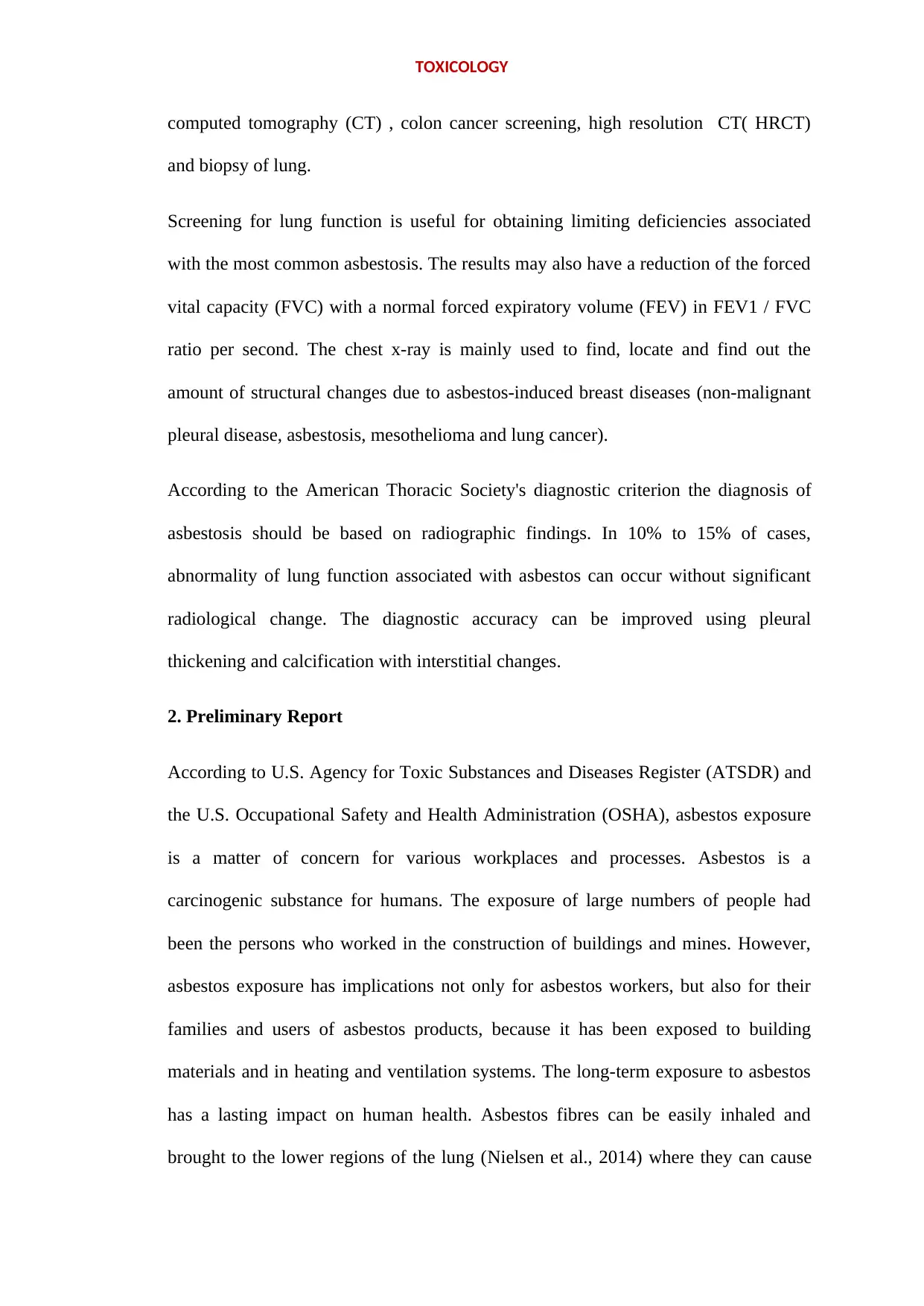
TOXICOLOGY
computed tomography (CT) , colon cancer screening, high resolution CT( HRCT)
and biopsy of lung.
Screening for lung function is useful for obtaining limiting deficiencies associated
with the most common asbestosis. The results may also have a reduction of the forced
vital capacity (FVC) with a normal forced expiratory volume (FEV) in FEV1 / FVC
ratio per second. The chest x-ray is mainly used to find, locate and find out the
amount of structural changes due to asbestos-induced breast diseases (non-malignant
pleural disease, asbestosis, mesothelioma and lung cancer).
According to the American Thoracic Society's diagnostic criterion the diagnosis of
asbestosis should be based on radiographic findings. In 10% to 15% of cases,
abnormality of lung function associated with asbestos can occur without significant
radiological change. The diagnostic accuracy can be improved using pleural
thickening and calcification with interstitial changes.
2. Preliminary Report
According to U.S. Agency for Toxic Substances and Diseases Register (ATSDR) and
the U.S. Occupational Safety and Health Administration (OSHA), asbestos exposure
is a matter of concern for various workplaces and processes. Asbestos is a
carcinogenic substance for humans. The exposure of large numbers of people had
been the persons who worked in the construction of buildings and mines. However,
asbestos exposure has implications not only for asbestos workers, but also for their
families and users of asbestos products, because it has been exposed to building
materials and in heating and ventilation systems. The long-term exposure to asbestos
has a lasting impact on human health. Asbestos fibres can be easily inhaled and
brought to the lower regions of the lung (Nielsen et al., 2014) where they can cause
computed tomography (CT) , colon cancer screening, high resolution CT( HRCT)
and biopsy of lung.
Screening for lung function is useful for obtaining limiting deficiencies associated
with the most common asbestosis. The results may also have a reduction of the forced
vital capacity (FVC) with a normal forced expiratory volume (FEV) in FEV1 / FVC
ratio per second. The chest x-ray is mainly used to find, locate and find out the
amount of structural changes due to asbestos-induced breast diseases (non-malignant
pleural disease, asbestosis, mesothelioma and lung cancer).
According to the American Thoracic Society's diagnostic criterion the diagnosis of
asbestosis should be based on radiographic findings. In 10% to 15% of cases,
abnormality of lung function associated with asbestos can occur without significant
radiological change. The diagnostic accuracy can be improved using pleural
thickening and calcification with interstitial changes.
2. Preliminary Report
According to U.S. Agency for Toxic Substances and Diseases Register (ATSDR) and
the U.S. Occupational Safety and Health Administration (OSHA), asbestos exposure
is a matter of concern for various workplaces and processes. Asbestos is a
carcinogenic substance for humans. The exposure of large numbers of people had
been the persons who worked in the construction of buildings and mines. However,
asbestos exposure has implications not only for asbestos workers, but also for their
families and users of asbestos products, because it has been exposed to building
materials and in heating and ventilation systems. The long-term exposure to asbestos
has a lasting impact on human health. Asbestos fibres can be easily inhaled and
brought to the lower regions of the lung (Nielsen et al., 2014) where they can cause
⊘ This is a preview!⊘
Do you want full access?
Subscribe today to unlock all pages.

Trusted by 1+ million students worldwide
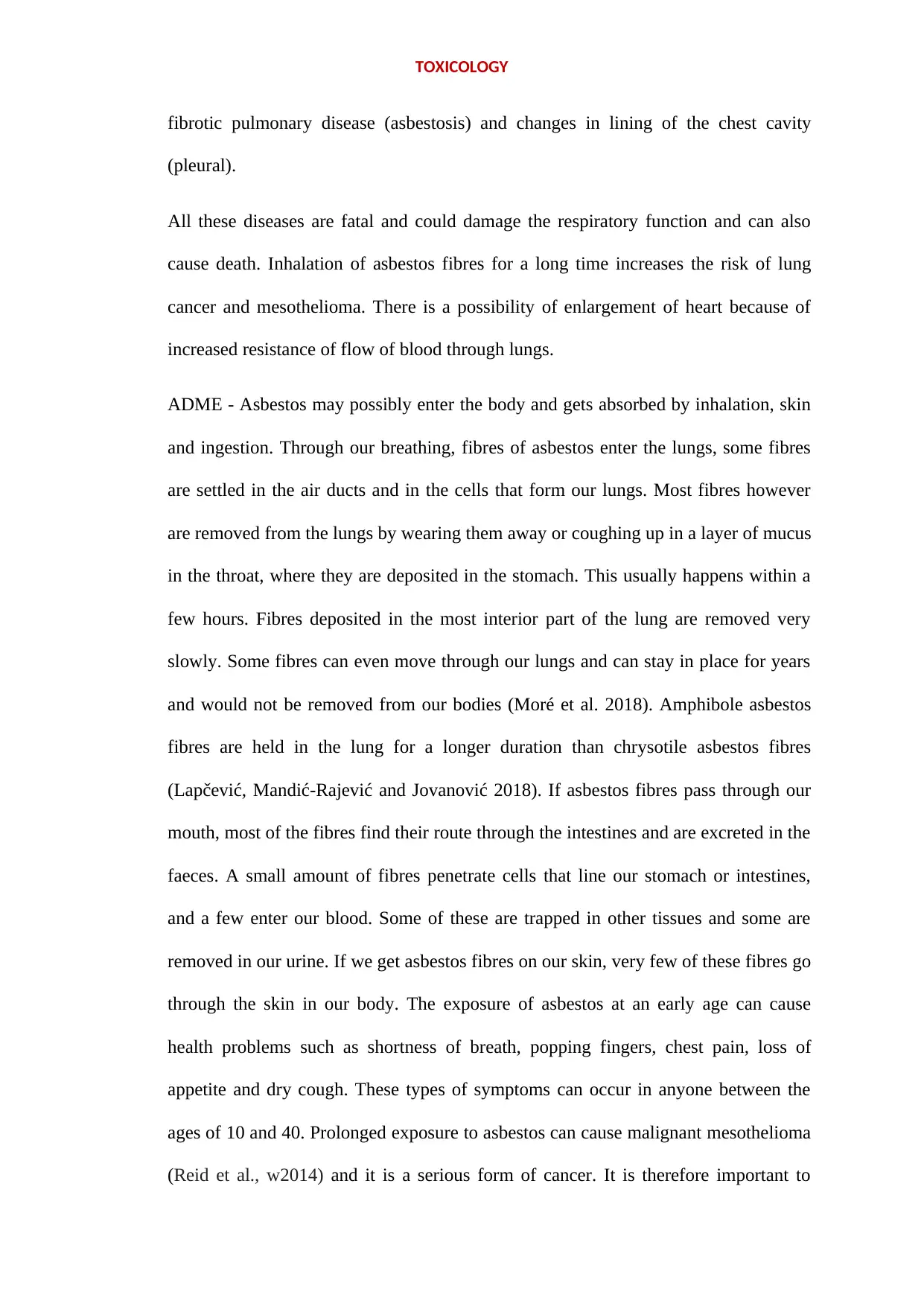
TOXICOLOGY
fibrotic pulmonary disease (asbestosis) and changes in lining of the chest cavity
(pleural).
All these diseases are fatal and could damage the respiratory function and can also
cause death. Inhalation of asbestos fibres for a long time increases the risk of lung
cancer and mesothelioma. There is a possibility of enlargement of heart because of
increased resistance of flow of blood through lungs.
ADME - Asbestos may possibly enter the body and gets absorbed by inhalation, skin
and ingestion. Through our breathing, fibres of asbestos enter the lungs, some fibres
are settled in the air ducts and in the cells that form our lungs. Most fibres however
are removed from the lungs by wearing them away or coughing up in a layer of mucus
in the throat, where they are deposited in the stomach. This usually happens within a
few hours. Fibres deposited in the most interior part of the lung are removed very
slowly. Some fibres can even move through our lungs and can stay in place for years
and would not be removed from our bodies (Moré et al. 2018). Amphibole asbestos
fibres are held in the lung for a longer duration than chrysotile asbestos fibres
(Lapčević, Mandić-Rajević and Jovanović 2018). If asbestos fibres pass through our
mouth, most of the fibres find their route through the intestines and are excreted in the
faeces. A small amount of fibres penetrate cells that line our stomach or intestines,
and a few enter our blood. Some of these are trapped in other tissues and some are
removed in our urine. If we get asbestos fibres on our skin, very few of these fibres go
through the skin in our body. The exposure of asbestos at an early age can cause
health problems such as shortness of breath, popping fingers, chest pain, loss of
appetite and dry cough. These types of symptoms can occur in anyone between the
ages of 10 and 40. Prolonged exposure to asbestos can cause malignant mesothelioma
(Reid et al., w2014) and it is a serious form of cancer. It is therefore important to
fibrotic pulmonary disease (asbestosis) and changes in lining of the chest cavity
(pleural).
All these diseases are fatal and could damage the respiratory function and can also
cause death. Inhalation of asbestos fibres for a long time increases the risk of lung
cancer and mesothelioma. There is a possibility of enlargement of heart because of
increased resistance of flow of blood through lungs.
ADME - Asbestos may possibly enter the body and gets absorbed by inhalation, skin
and ingestion. Through our breathing, fibres of asbestos enter the lungs, some fibres
are settled in the air ducts and in the cells that form our lungs. Most fibres however
are removed from the lungs by wearing them away or coughing up in a layer of mucus
in the throat, where they are deposited in the stomach. This usually happens within a
few hours. Fibres deposited in the most interior part of the lung are removed very
slowly. Some fibres can even move through our lungs and can stay in place for years
and would not be removed from our bodies (Moré et al. 2018). Amphibole asbestos
fibres are held in the lung for a longer duration than chrysotile asbestos fibres
(Lapčević, Mandić-Rajević and Jovanović 2018). If asbestos fibres pass through our
mouth, most of the fibres find their route through the intestines and are excreted in the
faeces. A small amount of fibres penetrate cells that line our stomach or intestines,
and a few enter our blood. Some of these are trapped in other tissues and some are
removed in our urine. If we get asbestos fibres on our skin, very few of these fibres go
through the skin in our body. The exposure of asbestos at an early age can cause
health problems such as shortness of breath, popping fingers, chest pain, loss of
appetite and dry cough. These types of symptoms can occur in anyone between the
ages of 10 and 40. Prolonged exposure to asbestos can cause malignant mesothelioma
(Reid et al., w2014) and it is a serious form of cancer. It is therefore important to
Paraphrase This Document
Need a fresh take? Get an instant paraphrase of this document with our AI Paraphraser

TOXICOLOGY
emphasize that children's health can be significantly affected by exposure to asbestos
and gradual accumulation can cause serious damage to health (Goswami et al. 2013).
emphasize that children's health can be significantly affected by exposure to asbestos
and gradual accumulation can cause serious damage to health (Goswami et al. 2013).
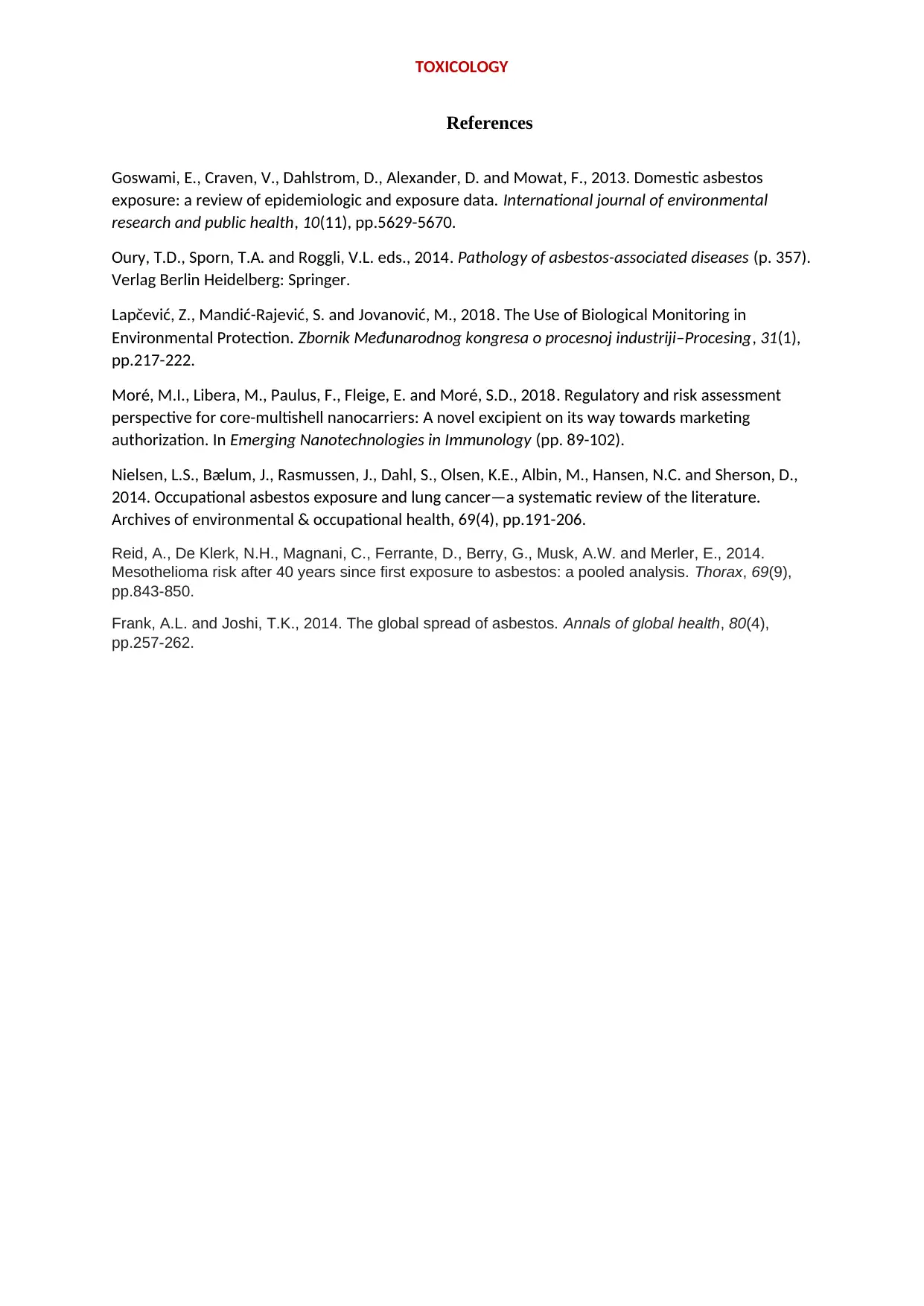
TOXICOLOGY
References
Goswami, E., Craven, V., Dahlstrom, D., Alexander, D. and Mowat, F., 2013. Domestic asbestos
exposure: a review of epidemiologic and exposure data. International journal of environmental
research and public health, 10(11), pp.5629-5670.
Oury, T.D., Sporn, T.A. and Roggli, V.L. eds., 2014. Pathology of asbestos-associated diseases (p. 357).
Verlag Berlin Heidelberg: Springer.
Lapčević, Z., Mandić-Rajević, S. and Jovanović, M., 2018. The Use of Biological Monitoring in
Environmental Protection. Zbornik Međunarodnog kongresa o procesnoj industriji–Procesing, 31(1),
pp.217-222.
Moré, M.I., Libera, M., Paulus, F., Fleige, E. and Moré, S.D., 2018. Regulatory and risk assessment
perspective for core-multishell nanocarriers: A novel excipient on its way towards marketing
authorization. In Emerging Nanotechnologies in Immunology (pp. 89-102).
Nielsen, L.S., Bælum, J., Rasmussen, J., Dahl, S., Olsen, K.E., Albin, M., Hansen, N.C. and Sherson, D.,
2014. Occupational asbestos exposure and lung cancer—a systematic review of the literature.
Archives of environmental & occupational health, 69(4), pp.191-206.
Reid, A., De Klerk, N.H., Magnani, C., Ferrante, D., Berry, G., Musk, A.W. and Merler, E., 2014.
Mesothelioma risk after 40 years since first exposure to asbestos: a pooled analysis. Thorax, 69(9),
pp.843-850.
Frank, A.L. and Joshi, T.K., 2014. The global spread of asbestos. Annals of global health, 80(4),
pp.257-262.
References
Goswami, E., Craven, V., Dahlstrom, D., Alexander, D. and Mowat, F., 2013. Domestic asbestos
exposure: a review of epidemiologic and exposure data. International journal of environmental
research and public health, 10(11), pp.5629-5670.
Oury, T.D., Sporn, T.A. and Roggli, V.L. eds., 2014. Pathology of asbestos-associated diseases (p. 357).
Verlag Berlin Heidelberg: Springer.
Lapčević, Z., Mandić-Rajević, S. and Jovanović, M., 2018. The Use of Biological Monitoring in
Environmental Protection. Zbornik Međunarodnog kongresa o procesnoj industriji–Procesing, 31(1),
pp.217-222.
Moré, M.I., Libera, M., Paulus, F., Fleige, E. and Moré, S.D., 2018. Regulatory and risk assessment
perspective for core-multishell nanocarriers: A novel excipient on its way towards marketing
authorization. In Emerging Nanotechnologies in Immunology (pp. 89-102).
Nielsen, L.S., Bælum, J., Rasmussen, J., Dahl, S., Olsen, K.E., Albin, M., Hansen, N.C. and Sherson, D.,
2014. Occupational asbestos exposure and lung cancer—a systematic review of the literature.
Archives of environmental & occupational health, 69(4), pp.191-206.
Reid, A., De Klerk, N.H., Magnani, C., Ferrante, D., Berry, G., Musk, A.W. and Merler, E., 2014.
Mesothelioma risk after 40 years since first exposure to asbestos: a pooled analysis. Thorax, 69(9),
pp.843-850.
Frank, A.L. and Joshi, T.K., 2014. The global spread of asbestos. Annals of global health, 80(4),
pp.257-262.
⊘ This is a preview!⊘
Do you want full access?
Subscribe today to unlock all pages.

Trusted by 1+ million students worldwide
1 out of 6
Related Documents
Your All-in-One AI-Powered Toolkit for Academic Success.
+13062052269
info@desklib.com
Available 24*7 on WhatsApp / Email
![[object Object]](/_next/static/media/star-bottom.7253800d.svg)
Unlock your academic potential
Copyright © 2020–2025 A2Z Services. All Rights Reserved. Developed and managed by ZUCOL.




